Afghanistan has pulled out of a tri-nation series with Pakistan and Sri Lanka next month after three local cricketers were killed in an attack, the country’s cricket board said on Friday.
The ACB said that the players had travelled from Urgun to…
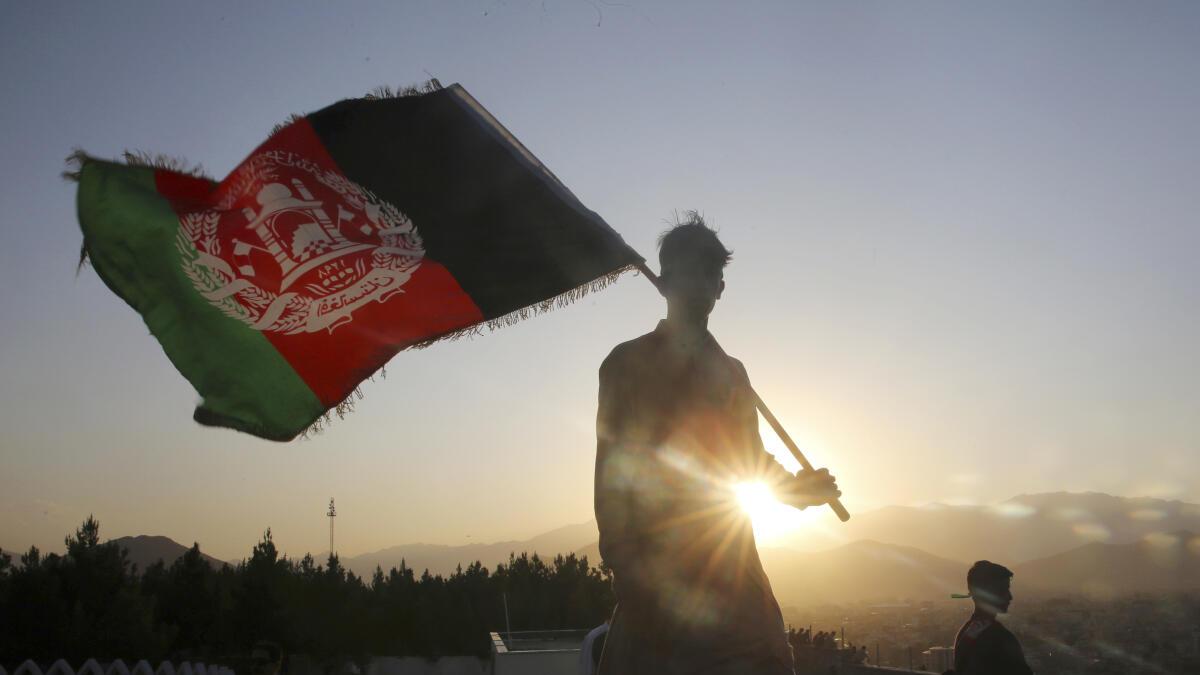
Afghanistan has pulled out of a tri-nation series with Pakistan and Sri Lanka next month after three local cricketers were killed in an attack, the country’s cricket board said on Friday.
The ACB said that the players had travelled from Urgun to…

The upcoming launch of ARC Raiders is one of my most looked-forward-to releases in a long time. Only one week after Battlefield 6 launched, we’ve been gifted with another look into Embark Studios’ upcoming killer release with their Server Slam…
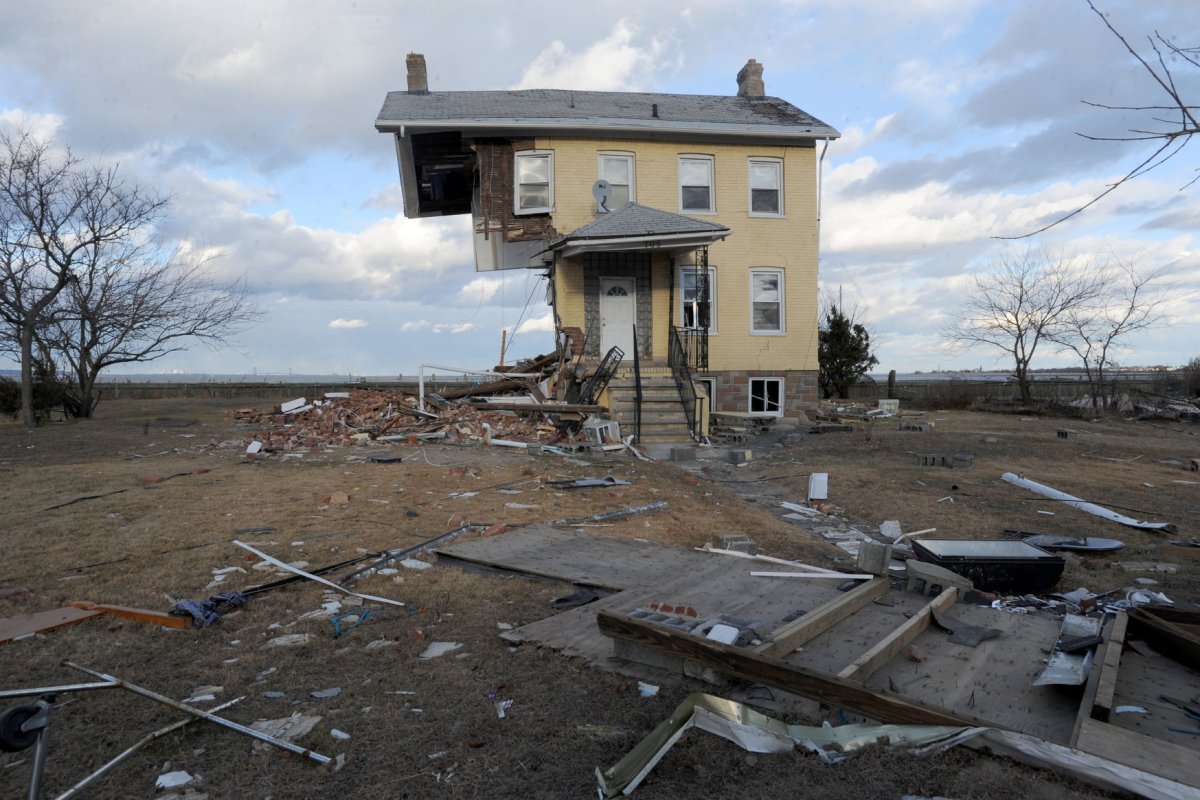
A new study published in JAMA Network Open, a monthly open-access medical journal published by the American Medical Association, has uncovered a long-term link between Hurricane Sandy flooding and increased heart disease risk in older adults…

Adjuvant abemaciclib (
Abemaciclib is a cyclin-dependent kinase 4/6 inhibitor targeted for cancer therapy, and the monarchE trial demonstrated a 15.8% reduction in risk of death vs ET (HR, 0.84; 95% CI, 0.72-0.98; P = .027) in the intent-to-treat population at a median follow-up of 76.2 months.1 The newly published data, which make abemaciclib the first therapy in more than 2 decades to show a significant overall survival (OS) benefit in this high-risk patient population, will also be submitted to global regulatory health authorities, according to a press release.2
“For patients, survival is what matters most—and abemaciclib plus ET represents the first contemporary medicine in over two decades to deliver a clear improvement in overall survival in the adjuvant setting,” said lead monarchE investigator Stephen Johnston, MD, PhD, professor of Breast Cancer Medicine and consultant medical oncologist at The Royal Marsden NHS Foundation Trust in London.2
The global, open-label, randomized phase 3 trial enrolled 5637 patients with high-risk, HR-positive, HER2-negative, early-stage breast cancer from July 2017 to August 2019.1 Patients were randomly assigned 1:1 to receive standard adjuvant ET alone (n = 2829) or ET combined with abemaciclib (n = 2808). Patients received at least 5 years of ET with or without 2 years of abemaciclib (150 mg twice daily). IDFS was defined as the time from the receipt of treatment until ipsilateral invasive disease, ipsilateral locoregional invasive disease, contralateral invasive breast cancer, distant recurrence, second primary non-breast invasive cancer, or death from any cause.
The primary OS analysis had a data cutoff of July 15, 2025, at which point there were 661 OS events—301 (10.7%) in the abemaciclib arm vs 360 (12.7%) in the ET-alone arm. At 60, 72, and 84 months, OS rates were 91.2%, 89.2%, and 86.8% in the abemaciclib plus ET arm vs 90.2%, 87.9%, and 85.0% in the ET arm. In both arms, most deaths were associated with breast cancer recurrence.
The most frequent adverse events (AEs) leading to death were infections (including COVID-19 infections), second primary neoplasm, and cardiac disorders, and there were no relevant differences in causes of death related to AEs in either treatment group.
Patients in the abemaciclib cohort also had a reduced risk of IDFS (HR, 0.73; 95% CI, 0.66-0.820; nominal P < .0001). The estimated IDFS rate was 83.1% in the abemaciclib plus ET arm at 5 years vs 76.5% in the ET arm; at 7 years, the estimated IDFS rates were 77.4% and 70.9%, respectively.
“These results represent an important advancement in the care of node-positive, high-risk, HR-positive, HER2-negative disease by delivering meaningful reductions in recurrence and improving survival,” Jacob Van Naarden, executive vice president and president of Lilly Oncology, said.2
The results are in line with prior data, with the initial IDFS analysis showing significant improvements with abemaciclib plus ET vs ET alone (HR, 0.75; 95% CI, 0.60-0.93; P = .01),3 and a 5–year analysis showing sustained improvements in both IDFS (HR, 0.68; 95% CI, 0.599-0.772; nominal P < .001) and DRFS (HR, 0.675; 95% CI, 0.588-0.774; nominal P < .001).4 At 5 years, there was a trend in OS improvement in the abemaciclib that was not yet statistically significant.
“To now have data showing a treatment helps more people live longer is a major step forward for our community,” said Sue Weldon, CEO of Unite for HER, in the Eli Lilly press release.2 “We mark this significant milestone while recognizing there’s more work ahead to ensure every eligible patient has the opportunity to benefit from treatments that can change lives.”
References
1. Johnston S, Martin M, O’Shaughnessy J, et al. Overall survival with abemaciclib in early breast cancer. Ann Oncol. Published online October 17, 2025. doi:10.1016/j.annonc.2025.10.005
2. Eli Lilly Inc.: Lilly’s Verzenio (abemaciclib) prolonged survival in HR+, HER2-, high-risk early breast cancer with two years of treatment. Published October 17, 2025. Accessed October 17, 2025.
3. Johnston SRD, Harbeck N, Hegg R, et al. Abemaciclib combined with endocrine therapy for the adjuvant treatment of HR+, HER2-, node-positive, high-risk, early breast cancer (monarchE). J Clin Oncol. 2020;38(34):3987-3998. doi:10.1200/JCO.20.02514
4. Rastogi P, O’Shaughnessy J, Martin M, et al. Adjuvant abemaciclib plus endocrine therapy for hormone receptor-positive, human epidermal growth factor receptor 2-negative, high-risk early breast cancer: results from a preplanned monarchE overall survival interim analysis, including 5-year efficacy outcomes. J Clin Oncol. 2024;42(9):987-993. doi:10.1200/JCO.23.01994
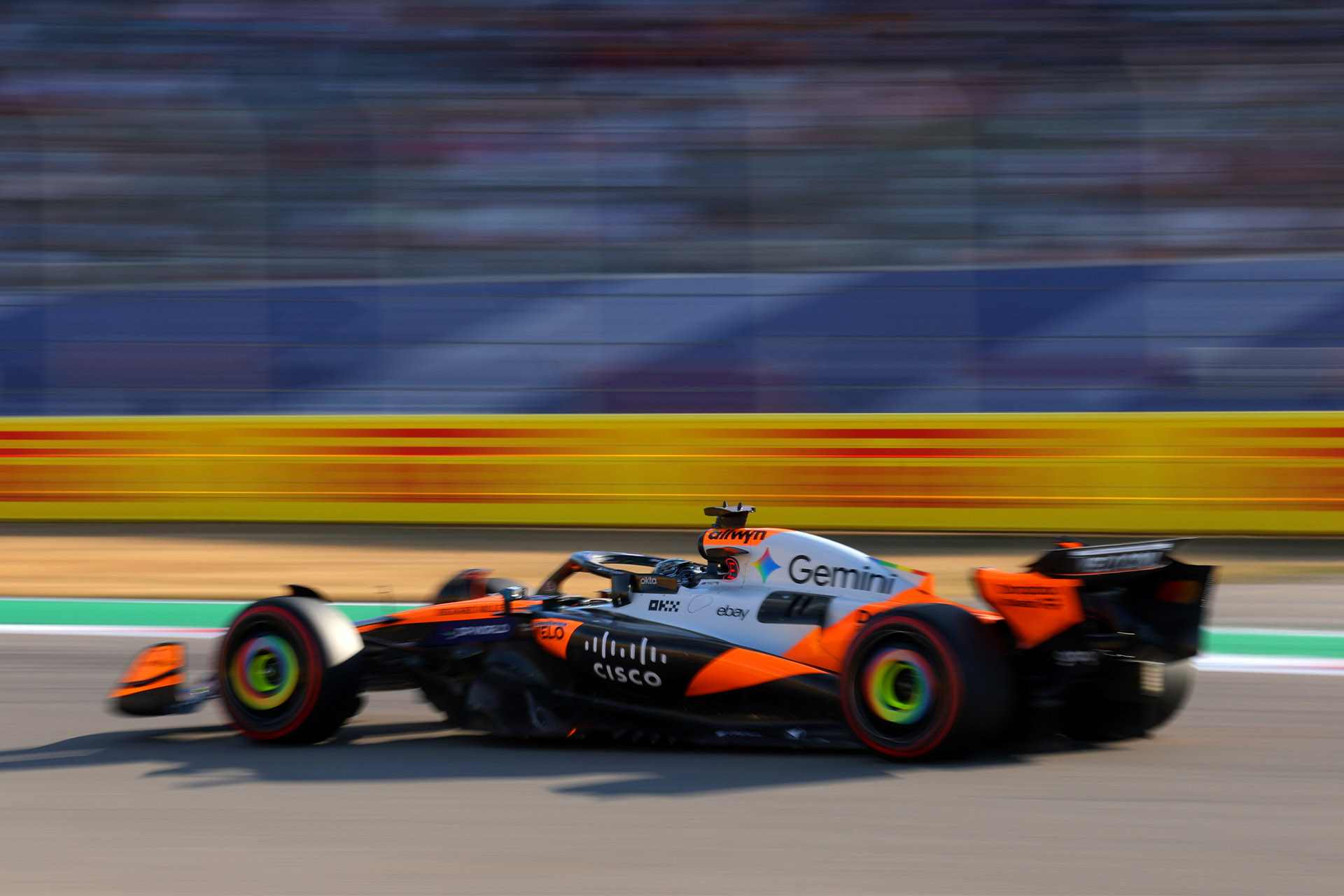
“A positive start to the weekend in Austin with a relatively comprehensive representation of the field. Today’s sessions confirm that our main competitor has improved their car and continues to provide close competition at the different types of…
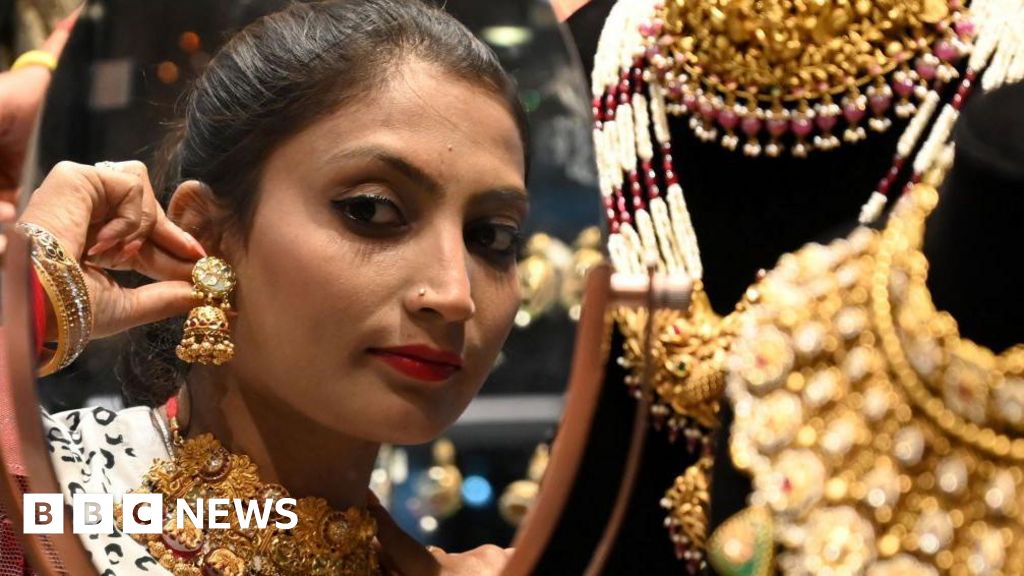
Anahita SachdevDelhi and
Nikhil InamdarMumbai
 Getty Images
Getty ImagesAhead of the Hindu festival of Diwali, the jewellery market in Indian capital Delhi’s vibrant Lajpat Nagar neighbourhood is teeming with crowds.
Shops have stayed open even on holidays, and at dusk, dozens of cars line up the streets as a string of flashy signboards beckon shoppers into the flower-adorned stores.
Soaring gold prices – which have topped $1,440 (£1,081) for 10g – may have slightly dented demand for jewellery in the world’s second largest market for the yellow metal this year, but Indians are not willing to entirely give up on their penchant for gold yet.
Diwali, along with Dhanteras – a smaller festival that falls on Saturday this year – are believed to be auspicious occasions to buy precious metal, with hundreds of thousands of Indians flocking the markets to buy gold and silver coins, bars and jewellery, which they believe bring wealth and luck.
Skyrocketing prices have created FOMO – or the fear of missing out – in the minds of buyers, who are worried prices might rise even further, Prakash Pahlajani, who runs Kumar Jewels, a family-owned business, told the BBC on a busy evening at his shop.
“As a result, I have more customers this year,” Mr Pahlajani said.
But with prices – gold is up 60% and silver 70% – shooting through the roof, jewellers are having to change tack to counter stagnant customer budgets.
“People are not saying ‘I don’t want to buy’. Instead, they are saying, ‘I’ll buy a little less,” said Tanishq Gupta, another jeweller down the road from Mr Pahlajani’s shop.
He said he’s had to be innovative and design pieces that look elaborate but have a reduced quantity of gold in them. A coin made of 250mg gold, which he sells for as low as $35, is now thinner but made to look as big as the heavier ones.
Coins weighing a tenth of that, at 25mg, are also on offer in the market.
Pushpinder Chauhan, another retailer in the area, said higher prices had also exacerbated the growing preference for lighter jewellery this year, “especially among younger buyers” who want pieces for everyday wear and not just special occasions.
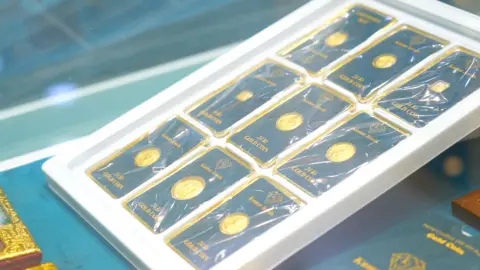
Several jewellers the BBC spoke to pointed to another clear trend – more customers were buying gold and silver for investment rather than jewellery this year, something that is also reflected in bullion market data.
While gold jewellery continues to account for the largest share of India’s overall gold demand, the proportion driven by investment – primarily bars and coins – has been rising steadily, according to the World Gold Council (WGC).
“Jewellery’s share declined to 64% in the second quarter of this year, from 80% in the same period in 2023, while investment demand increased from 19% to 35% over the same period,” Kavita Chacko, the council’s research head, told the BBC.
A lot of that demand is also being fed by investment in exchange-traded funds (ETFs) or digital gold, where September marked record high inflows.
ETF assets under management have surged by over 70% this year.
Besides retail demand, gold prices are also being significantly influenced by India’s central bank, with the metal’s share in its foreign exchange reserves rising from 9% to 14% in 2025, according to WGC.
In fact, the Reserve Bank of India (RBI) has been “a major pillar of global gold demand over the past three years”, said Kaynat Chainwala who tracks commodities at Kotak Securities, a broking house.
She said the RBI has been stocking up on gold in a bid to diversify its foreign exchange holdings, reduce its dependence on the dollar and provide stability during geopolitical stress.
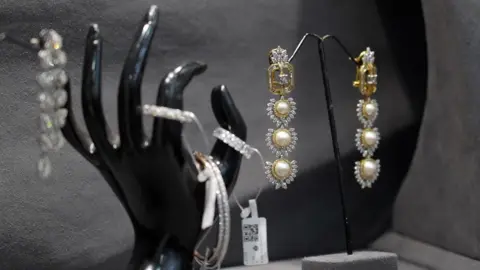
Going forward, with the festive and the wedding season under way, retail demand for gold and silver is expected to continue to hold up despite record-high prices, say experts.
“The affluent classes will continue to buy, though it is a setback for lower income families,” said Madan Sabnavis, the chief economist at the state-run Bank of Baroda. “Demand will hold up in value terms, even though volumes will fall.”
But some families have been totally priced out of the market.
“I am now having to think a lot while buying – about whether to even get something,” Bhavna, who’s getting married in February, told the BBC outside Mr Pahlajani’s jewellery store.
For the moment, she’s held off her purchases and is waiting for prices to fall a bit so that she can come back to finish her wedding shopping.
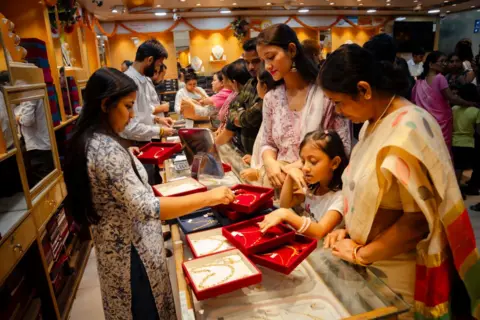 NurPhoto via Getty Images
NurPhoto via Getty ImagesSuch strong cultural affinity for physical gold, particularly jewellery, means the appetite for the noble metal is unlikely to be dented in the long term, despite the short-term moderation, say experts.
This is especially true for a country where high gold holdings have given solid long-term returns, making many Indians affluent at a time when growth is stumbling and jobs are hard to come by.
According to the US investment bank Morgan Stanley, Indian households held a staggering $3.8tn of gold, equivalent to 88.8% of the country’s GDP.
“This implies a positive wealth effect on the household balance sheet, given the uptrend in gold prices,” Economists Upasana Chachra and Bani Gambhir wrote in a recent note, adding that Indian families are also benefitting from “cyclical factors of lower interest payments with monetary policy easing, and the positive impact on disposable income through direct and indirect tax cuts”.
That’s not a bad start to the festive season, even though record prices may have taken some glitter off the precious metal.
Follow BBC News India on Instagram, YouTube, X and Facebook.
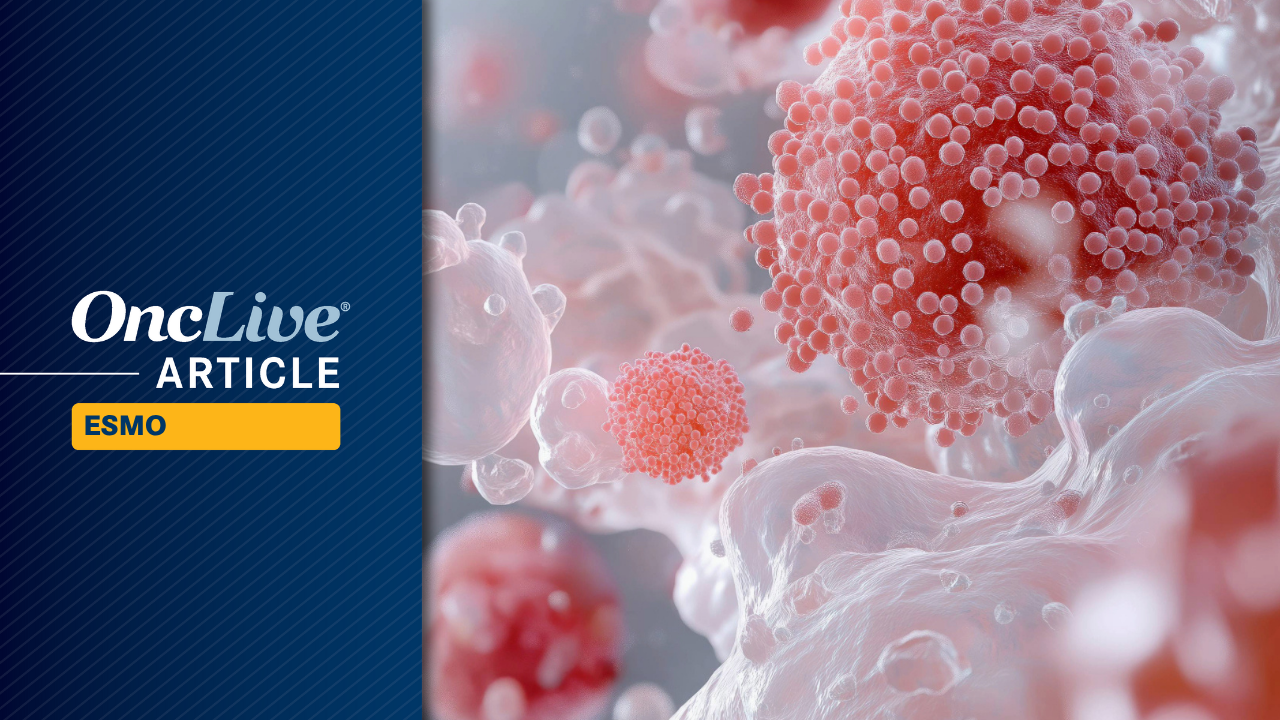
Long-term data from the phase 3 MANUEVER trial (NCT05804045) demonstrated that treatment with pimicotinib (ABSK021) led to robust and durable responses in patients with tenosynovial giant cell tumor (TGCT).1
Findings presented at the
MANEUVER Trial Highlights
The 6- and 12-month duration of response (DOR) rates per BICR assessment and RECIST 1.1 criteria were 98% (95% CI, 84%-100%) and 92% (95% CI, 70%-98%), respectively.
“Pimicotinib offers an effective, convenient, and tolerable systemic treatment option for patients with TGCT, providing early and durable tumor response with sustained relief from pain and functional impairments,” lead study author Xiaohui Niu, MD, of the Department of Orthopaedic Oncology Surgery at Beijing Ji Shui Tan Hospital at Peking University in China, said during a presentation of the data.
MANEUVER was a global, randomized, double-blind, placebo-controlled study evaluating pimicotinib—a highly selective and potent, small molecule CSF-1R inhibitor—in patients at least 18 years of age with histologically confirmed, unresectable TGCT who had measurable disease per RECIST 1.1 criteria with at least 1 lesion measuring at least 2 cm. Patients also needed to have symptomatic disease due to active TGCT.
The trial was double-blinded for the first 24 weeks, where patients were randomly assigned 2:1 to receive pimicotinib orally at 50 mg once per day (n = 63) or matched placebo (n = 31).
After week 24, the trial entered its open-label extension period, where patients in the experimental arm continued to receive pimicotinib, and those in the placebo arm crossed over to receive the agent.1
Along with the primary end point of ORR per RECIST 1.1 criteria at week 25, secondary end points included ORR by TVS at week 25; and mean change from baseline to week 25 in range of motion, pain, stiffness, and PROMIS-PF T-score.
Findings also showed that patients treated with pimicotinib experienced clinically meaningful improvements in all clinical outcome assessments with longer-term follow-up, with durable improvements lasting beyond 1 year. Additionally, patients in the placebo arm who crossed over to receive pimicotinib had an ORR by BICR of 64.5% per RECIST v1.1 and TVS criteria at a median follow-up of 260 days (range, 85-505).
Regarding safety, the most common clinical adverse effects (AEs) reported in patients who received pimicotinib from baseline included pruritus (all-grade, 60.3%; grade 3/4, 3.2%), facial edema (49.2%; 0%), rash (38.1%; 6.3%), periorbital edema (36.5%; 0%), fatigue (28.6%; 0%), nausea (28.6%; 0%), and headache (25.4%; 0%).
Laboratory AEs were composed of increased blood creatine phosphokinase levels (all-grade, 71.4%; grade 3/4, 15.9%), increased blood lactate dehydrogenase levels (57.1%; 0%), increased aspartate aminotransferase levels (55.6%; 0%), increased amylase levels (38.1%; 0%), increased alpha-HBDH levels (25.4%; 0%), increased lipase levels (27.0%; 3.2%), increased blood creatine kinase MB levels (20.6%; 0%), and increase alanine aminotransferase levels (22.2%; 0%).
Disclosures: Niu did not list any conflicts of interest.
The Secretary-General is gravely concerned by the continued public accusations made by the Houthis, including on 16 October by their leadership, against United Nations personnel in Yemen. He categorically rejects all such accusations.
The…
The Secretary-General is gravely concerned by the continued public accusations made by the Houthis, including on 16 October by their leadership, against United Nations personnel in Yemen. He categorically rejects all such accusations.
The…